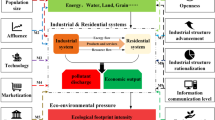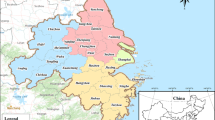Abstract
In the urbanizing world, the Yangtze Delta Region (YDR) as one of the most developed regions in China, has drawn a lot of the world’s attention for the remarkable economic development achieved in the past decades. Nevertheless, the rapid economic development was certain to be accompanied by unprecedented consumption and loss of natural resources. Therefore, the analysis of the ecological situation and driving factors of environmental impact was of great significance to serve the local sustainable development decision-making and build a harmonious society. In this paper, the ecological footprint (EF) was taken as the index of the ecological environmental impact. With the help of Geographic Information System (GIS), we studied the spatiotemporal change of ecological footprint at two scales (region and city) and assessed urban sustainable development ability in YDR. Then we discussed the driving factors that affected the change of ecological footprint by the Stochastic Impacts by Regression on Population, Affluence, and Technology (STIRPAT) model. The results showed that increasing trends of regional ecological footprint during 1998–2008 (1.70–2.53 ha/cap) were accompanied by decreasing ecological capacity (0.31–0.25 ha/cap) but expanding ecological deficit (1.39–2.28 ha/cap). The distribution pattern of ecological footprint and the degree of sustainable development varied distinctly from city to city in YDR. In 2008, the highest values of ecological footprint (3.85 ha/cap) and the lowest one of sustainable development index (SDI=1) in YDR were both presented in Shanghai. GDP per capita (A) was the most dominant driving force of EF and the classical EKC hypothesis did not exist between A and EF in 1998–2008. Consequently, increasing in ecological supply and reducing in human demand due to technological advances or other factors were one of the most effective ways to promote sustainable development in YDR. Moreover, importance should be attached to change our definition and measurement of prosperity and success.
Similar content being viewed by others
References
Bagliani M, Bravo G, Dalmazzone S, 2008. A consumption-based approach to Environmental Kuznets Curves using the ecological footprint indicator. Ecological Economics, 65(3): 650–661.
Cheng Shengkui, Xie Gaodi, Cao Shuyan et al., 2008. Report on ecological footprints of China. Website: http://www.footprintnetwork.org. (in Chinese)
Dietz T, Rosa E A, 1994. Rethinking the environmental impacts of population, affluence and technology. Human Ecology Review, 1(1): 277–300.
Dietz T, Rosa E A, York R, 2007. Driving the human ecological footprint. Frontiers in Ecology and the Environment, 5(1): 13–18.
Duan Xuejun, Yu Xiaogan, Nipper Josef, 2009. Economic polarized trends, function and expanded boundaries of the Yangtze Delta Region. Journal of Geographical Sciences, 19(6): 733–749.
He Xiaoqun, Liu Wenqing, 2001. Analysis of Applied Regression. Beijing: China Renmin University Press, 169–184. (in Chinese)
Jia Junsong, Deng Hongbing, Duan Jing et al., 2009. Analysis of the major drivers of the ecological footprint using the STIRPAT model and the PLS method: A case study in Henan Province, China. Ecological Economics, 68(11): 2818–2824.
Jorgenson A K, Clark B, 2010. Assessing the temporal stability of the population/environment relationship in comparative perspective: A cross-national panel study of carbon dioxide emissions, 1960–2005. Population and Environment, 32(1): 27–41.
Liddle B, Lung S, 2010. Age-structure, urbanization, and climate change in developed countries: Revisiting STIRPAT for disaggregated population and consumption-related environmental impacts. Population and Environment, 31(5): 317–343.
Lin Shoufu, Zhao Dingtao, Marinova Dora, 2009. Analysis of the environmental impact of China based on STIRPAT model. Environmental Impact Assessment Review, 29(6): 341–347.
Long Aihua, Xu Zhongmin, Wang Xinhua et al., 2006. Impacts of population, affluence and technology on water footprint in China. Acta Ecological Sinica, 26(10): 3359–3365. (in Chinese)
Moran D D, Wackernagel M, Kitzes J A et al. 2008. Measuring sustainable development: Nation by nation. Ecological Economics, 64(3): 470–474.
National Bureau of Statistics of China, 2010. China Statistical Yearbook. Beijing: China Statistics Press. (in Chinese)
National Development and Reform Commission, 2010. Regional Plan for the Yangtze River Delta. Website: http://www.ndrc.gov.cn. (in Chinese)
Rees W E, 1992. Ecological footprints and appropriated carrying capacity: What urban economics leaves out. Environment and Urbanization, 4(2): 121–130.
Suzuki H, Dastur A, Moffatt S et al., 2009. Eco-cities. Washington: World Bank. Website: http://www.worldbank.org
Wachernagel M, Lewan L, Hanson C B, 1999. Evaluating the use of natural capital with the ecological footprint: Application in Sweden and subregions. Ambio, 28(7): 604–612.
Wackernagel M, Yount J D, 1998. The ecological footprint: An indicator of progress toward regional sustainability. Environmental Monitoring and Assessment, 51: 511–529.
Wang Mingquan, Liu Jingshuang, Wang Jinda et al. 2010. Ecological footprint and major driving forces in west Jilin Province, Northeast China. Chinese Geographical Science, 20(5): 434–440.
Wang Shuyu, Bian Xinmin, 2008. Improved method of ecological footprint: Funing County ecological economic system assessments. Environment, Development and Sustainability, 10(3): 337–347.
World Wild Fund for Nature (WWF). Living Planet Report 2007. http://www.panda.org.
World Wild Fund for Nature (WWF). Living Planet Report 2010. http://www.footprintnetwork.org.
York R, Rosa E A, Rosa T, 2003. STIRPAT, IPAT and ImPACT: Analytic tools for unpacking the driving forces of environmental impacts. Ecological Economics, 46(3): 351–365.
Zhang Tongji, Zhao Yanwen, Zhu Shanshan, 2007. Research on land use division of Yangtze River Delta based on SPSS. Acta Agriculture Jiangxi, 19(11): 77–80. (in Chinese)
Author information
Authors and Affiliations
Corresponding author
Additional information
Foundation: National Natural Science Foundation of China for Young Scholars, No.50808048; The Humanities and Social Science Research Projects of the Ministry of Education, No.07JA630036
Author: Wang Ping (1980–), Ph.D, specialized in urban ecological planning and regional sustainable development.
Rights and permissions
About this article
Cite this article
Wang, P., Wang, X. Spatiotemporal change of ecological footprint and sustainability analysis for Yangtze Delta Region. J. Geogr. Sci. 21, 859–868 (2011). https://doi.org/10.1007/s11442-011-0885-y
Received:
Accepted:
Published:
Issue Date:
DOI: https://doi.org/10.1007/s11442-011-0885-y




